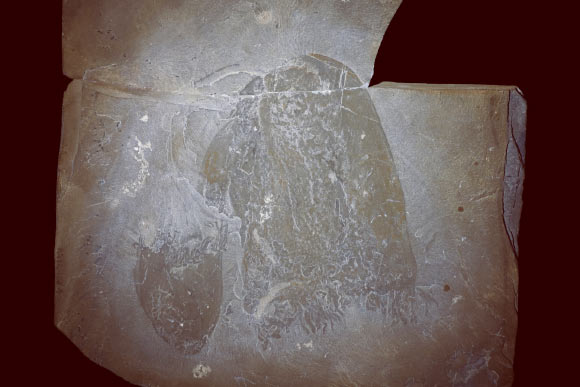Burgessomedusa phasmiformis had a cuboidal umbrella up to 20 cm (8 inches) high and over 90 short, finger-like tentacles.

Artistic reconstruction of a group of Burgessomedusa phasmiformis swimming in the Cambrian sea. Image credit: Christian McCall.
Cnidarians — one of the oldest groups of animals to have existed — have complex life cycles with one or two body forms: a vase-shaped body called a polyp and a bell or saucer-shaped body called a medusa or jellyfish, which can be free-swimming or not.
While fossilized polyps are known in 560-million-year-old rocks, the origin of the free-swimming medusa or jellyfish is not well understood.
Fossils of any type of jellyfish are extremely rare. As a consequence, their evolutionary history is based on microscopic fossilized larval stages and the results of molecular studies from living species.
Burgessomedusa phasmiformis lived during the Cambrian period, 500 million years ago, making it the oldest macroscopic free-swimming medusa in the fossil record.
By comparison with modern jellyfish, the new species would have been capable of free-swimming and the presence of tentacles would have enabled capturing sizeable prey.
“Burgessomedusa phasmiformis unambiguously shows that large, swimming jellyfish with a typical saucer or bell-shaped body had already evolved more than 500 million years ago,” said Joe Moysiuk, a Ph.D. candidate at the University of Toronto and the Royal Ontario Museum, and his colleagues.

Slab showing one large and one small bell-shaped specimens of Burgessomedusa phasmiformis. Image credit: Jean-Bernard Caron, Royal Ontario Museum.
The paleontologists examined 182 exceptionally preserved body fossils of Burgessomedusa phasmiformis — some of which were more than 20 cm in length — from the Burgess Shale in British Columbia, Canada.
“Although jellyfish and their relatives are thought to be one of the earliest animal groups to have evolved, they have been remarkably hard to pin down in the Cambrian fossil record,” Moysiuk said.
“Our discovery leaves no doubt they were swimming about at that time.”
The findings show that the Cambrian food chain was far more complex than previously thought, and that predation was not limited to large swimming arthropods like Anomalocaris.
“Finding such incredibly delicate animals preserved in rock layers on top of these mountains is such a wonderous discovery,” said Dr. Jean-Bernard Caron, a paleontologist at the University of Toronto and the Royal Ontario Museum.
“Burgessomedusa phasmiformis adds to the complexity of Cambrian food webs, and like Anomalocaris which lived in the same environment, these jellyfish were efficient swimming predators.”
“This adds yet another remarkable lineage of animals that the Burgess Shale has preserved chronicling the evolution of life on Earth.”
The discovery is reported in a paper in the Proceedings of the Royal Society B.
_____
Moon Justin et al. 2023. A macroscopic free-swimming medusa from the middle Cambrian Burgess Shale. Proc. R. Soc. B 290 (2004): 20222490; doi: 10.1098/rspb.2022.2490







